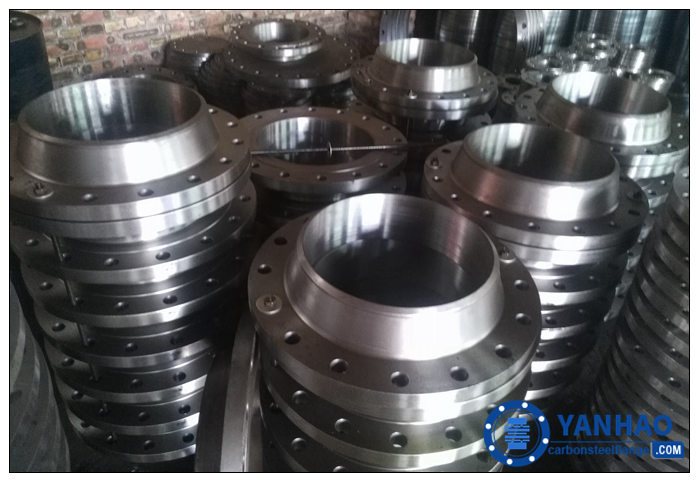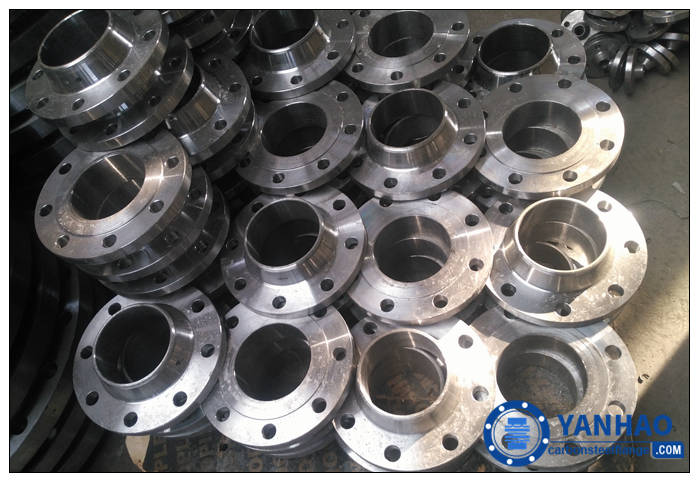What is a flange?
It is mentioned that many friends in Flange may not know very well, and we don’t see too many in our daily lives. I am also very curious about this name. Even I have mistaken this name for what kind of food or delicacy. name.
In fact, the name flange is a transliteration of flange. It was first proposed by an Englishman named Elchart in 1809, and also proposed the method of casting flange at the same time, but it did not exist for quite a while. Widely used, until the beginning of the twentieth century, flanges were widely used in various mechanical equipment and pipeline connections.
What is flange
Flanges are also called flange convex discs or convex discs. For those who engage in mechanical or engineering installation, flanges should be very familiar. It is a disc-shaped part and is generally used in pairs.

ANSI B16.5 Class 400 Welding Neck Flanges
It is mainly used for parts that connect between pipelines and valves, between pipelines and pipelines, and between pipelines and equipment to play a sealing role. Because there are many applications between these equipment and pipelines, so The two planes are connected by bolts, and the connecting parts with sealing effect are called flanges.
Generally, the flanges have round holes for fixing purposes. For example, when used at the pipe connection, add a sealing ring between the two flanges, and then tighten the connection with bolts. Flanges with different pressures have Different thicknesses and different bolts are used. The main materials used for flanges are carbon steel, stainless steel, alloy steel and so on.
Because the flange plays an important role and has good comprehensive performance, it is widely used in the chemical, petrochemical, fire and drainage industries.
Flanges are widely used internationally as a connecting piece, which requires a unified standard. For example, there are currently two standard systems for pipe flanges.
They are the European pipe flange system, that is, the European pipe flange system represented by German DIN (including Russia), and the American flange system represented by American ANSI pipe flanges.
In addition to the Japanese JIS pipe flange system, China also has the steel pipe flange system GB, but the main dimensions are still based on the European system and the American system.
Types of flanges
The structure of the flange is relatively simple. It is composed of three parts: the upper and lower flange pieces, the middle gasket, and several bolts and nuts.
From the definition of flanges, we can know that there are many kinds of flanges, and their classification needs to be distinguished from different dimensions. For example, flanges can be divided into integral flanges, flat welding flanges, and butt welding flanges according to the connection method. Loose flanges and threaded flanges, these are also common flanges.
Integral flange (IF) is generally used in pipelines with high pressure. It is a flange connection method and has a long neck. It is formed by one-time integral casting. The materials used are generally carbon steel and stainless steel. Wait.

ANSI B16.5 Class 150 Welding Neck Flanges
The flat welding flange is also called the tower welding flange, which refers to the welding method when connecting with the container or pipeline. This flat welding flange has the characteristics of easy assembly and low price. It is mainly used for pressure and Vibration is relatively small in the pipeline.
Butt welding flanges are also called high neck flanges. The biggest difference between butt welding flanges and other flanges is that they have a protruding high neck. The wall thickness of the protruding high neck will gradually match the thickness of the pipe wall to be connected with the height. Like the diameter, this will increase the strength of the flange. Butt-welded flanges are mainly used in places with relatively large environmental changes, such as high-temperature, high-pressure and low-temperature pipelines.
Loose flanges are also called loose flanges. These flanges are mostly used on some non-ferrous metals and stainless steel pipes. The connection is also realized by welding. Because it can be rotated and easily aligned with the bolt holes, it is mostly used in Large-diameter pipes and joints that often need to be disassembled, but loose flanges are not pressure-resistant, so they can only be used for low-pressure pipe connections.
The threaded flange has threads in the flange plate, which requires that the internally connected pipes also have external threads to realize the connection. It is a non-welded flange, so compared with other welding flanges, it has the advantage of convenient installation and disassembly. Threaded flanges are not suitable for use in extremely high or low temperature environments, because the threads are prone to pipeline leakage after thermal expansion and contraction.
Flange production process
Flange, as a kind of connecting and sealing parts, will leak if there are quality problems during the production process, causing economic losses, environmental damage and even safety accidents. Therefore, the welding and production of flanges are very important.
At present, the main production processes of flanges are forging and casting. Let's take a look at these two main production processes and see what is the difference between them.
Forged flange
Forged flanges are beaten countless times by a forging machine to make the internal structure of the steel compact, so the mechanical properties will be better, and the strength will be high. The forged flanges are mainly suitable for those pipes with higher pressure. .
The first is to cut the cylindrical billet to a certain size, heat it to a certain temperature to make it thermoplastic, and place it on the cold heading machine to continuously beat the billet to make the billet more compact and mechanical properties Better than the original billet.
The round hole on the flange is also punched out on the billet by a punching machine. The formed blank flange should be put into an electric furnace for heat treatment to increase the strength of the flange. Finally, the flange blank should be cut and polished to become a usable flange. .
Cast flange
Casting flanges have the characteristics of low manufacturing cost and high efficiency, and can produce flanges with more complicated shapes. Casting flanges are mainly suitable for those pipelines with lower pressure.

ASME B16.47 Class 400 Series B Welding Neck Flanges
Casting flange is also a commonly used manufacturing process. It is to melt metal into liquid molten steel, pour the molten steel into a metal mold that is preheated and maintained at a constant temperature to form the shape of the flange. After the casting is naturally cooled and formed for a period of time, Then use water to quickly cool down and release the mold, which can also increase the strength of the flange. Finally, it can be used after polishing and anti-rust treatment.
Although small parts such as flanges are not prominent in the entire product, pipeline or machinery, the role played by the flange is very important. With the development of flange materials and technology in the future, the entire joint connection process can be guaranteed The medium is more precise and firm, ensuring safe and reliable use by people.

